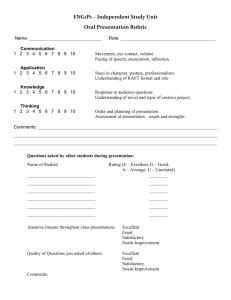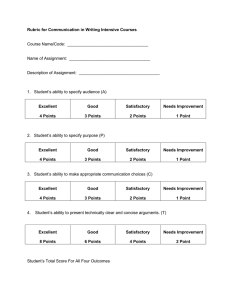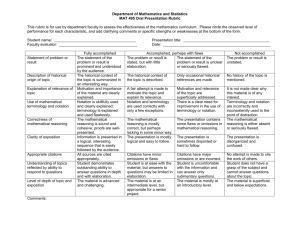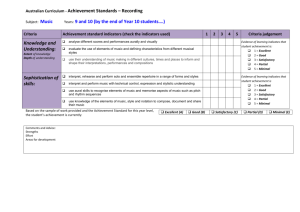Assessment Report - June, 2006 Bachelor's Degree Program in Mathematics Goal 1:
advertisement
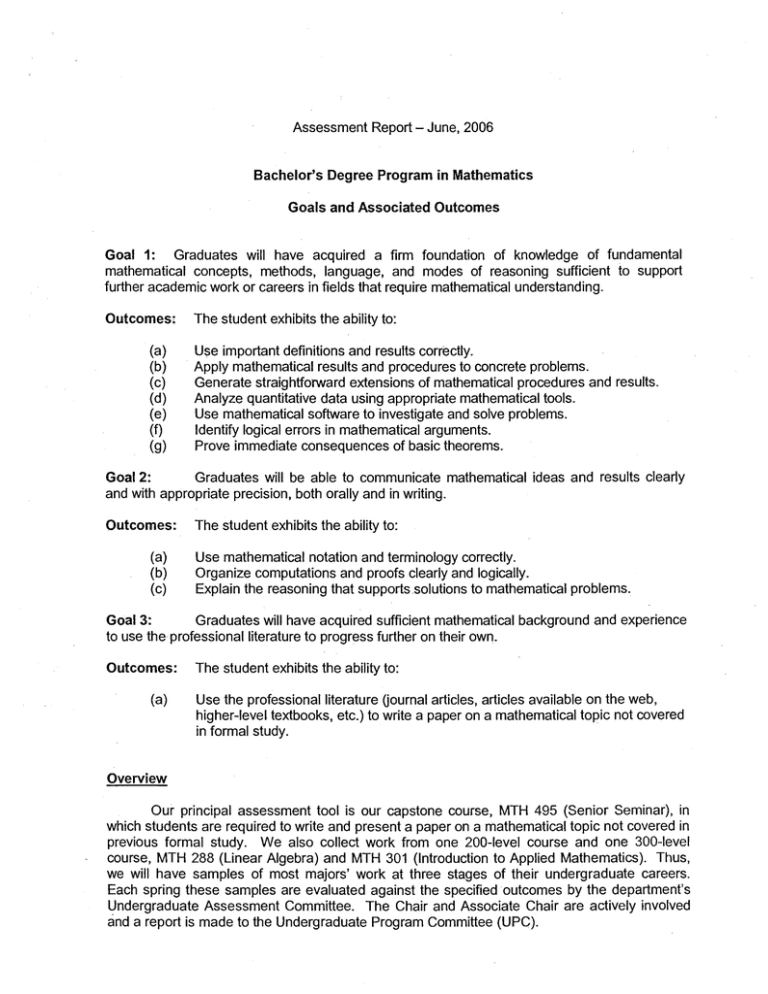
Assessment Report - June, 2006
Bachelor's Degree Program in Mathematics
Goals and Associated· Outcomes
Goal 1: Graduates will have acquired a firm foundation of knowledge of fundamental
mathematical concepts, methods, language, and modes of reasoning sufficient to support
.further academic work or careers in fields that require mathematical understanding.
Outcomes:
(a)
(b)
(c)
(d)
(e)
(f)
(g)
The student exhibits the ability to:
U$e important definitions and results correctly.
Apply mathematical results and procedures to concrete problems.
Generate straightfo'rward extensions of mathematical procedures and results.
Analyze quantitative data using appropriate mathematical tools.
Use. mathematical software to investigate and solve problems.
Identify logical errors in mathematical arguments.
Prove immediate consequences of basic theorems.
Goal 2:
Graduates will be able to communicate mathematical ideas and results clearly
and with appropriate precision, both orally and in writing.
Outcomes:
(a)
(b)
(c)
The student exhibits the ability to:
Use mathematical notation and terminology correctly.
Organize computations and proofs clearly and logically.
Explain the reasoning that su·pports.solutions to mathematical problems..
GO'at 3:
Graduates will have acquired sufficient mathematical background and experience
to use the· professional literature to progr~ss further on their own.
Outcomes:
(a)
The student exhibits the ability to:
Use the professional literature Qournal articles, articles available on the web,
higher-level textbooks, etc.) to write a paper on a mathematical topic not covered
in formal study.
Overview
Our principal assessment tool is our capstone course, MTH 495 (Senior Seminar), in
which students are required to write and present a paper on a mathematical topic not covered in
previous formal study. We also collect work from one 200-level course and one 300-level
course, MTH 288 (Linear Algebra) and MTH 301 (Introduction to Applied Mathematics). Thus,
we will have samples of most majors' work at three stages of their undergraduate careers.
Each spring these samples are evaluated against the specified ·outcomes by the departmenfs
Undergraduate Assessment Committee. The Chair and Associate Chair are actively involved
and a report is made to the Undergraduate Program Committee (UPC).
Goals and Outcomes
Early attempts at departmental self-assessment of the undergraduate program lacked
measurable outcomes and were excessively complex. The present colfection above was
developed in Fall 2002 using input from the UPC and open meetings and agreed to by the entire
department. They have served us well and have not been changed since then.
Research Methods
For MTH 288, we coUeet aU of the final exams from the Fan Semester each year and
evaluate each with a 5 point rubric on Goal 1 Outcomes a and b, and Goal 2, Outcomes a, b,
and c. This instrument has not been modified. The checksheet and scoring rubric is attached.
f
For MTH· 301, we collect the major proJects from the Fall Semester each year and
evaluate each with a 6 point rubric on Goal 1., Outcomes a, b, d, and· e, and Goal 2, OutcomE?s
a" b, and c. This instrument has not been modified. The checksheet and scoring rubric is
attached.
For MTH 495, we collect the course papers from the Fall Semester each year and
evaluate each with ~ 9 point rubric that covers aU of Goals 1, 2, and 3 above with each of their
Outcomes. This instrument was modified this year to fit the projects more closely and allow for
a niore substantial, differentiated evaluation. This new checklist is attached.
. One indirect method the ch'air used in the past was exit interviews for gradu'ating math
majors. We were told several years ago and again last year by the outside consultant that this
was not a valid approach, so exit interviews are no longer scheduled. Anew chair win begin
July 1, 2006, and the exit interview and other indirect·methods will be·considered.
Findings
For MTH 288, the average score for the 16 students was 18.5, which was vastly higher
than the 11.42 average of the previous year. Reasons for the increase are the much better
perfofr;nance of the students, the clarity of expectations of the instructor, and the fact that part of
the final· (for the first time) was completed outside of class.
For MTH 301 the average score for the 19 students was 32.77 which was significantly
higher than the 24.9 average of the previous year. We had focused on a better alignment of the
project with the goars and outcomes and also did a better job of selecting possible topics for the
students to work on. The instructor also required a first draft that was to be re-worked prior to
the final· submission.
J
J
For MTH 495, the average score for the 20 students was 7.91, which was significantly
higher than the 5.41 average of the previous year. This reflects the improved instrument as well
as the instructor's expertise in dealing with these papers, and the students' response to more
explicit instructions.
Review
For MTH 288, the data were analyzed in the Spring Semester, 2006, by a three-person
committee with input from the Ch~ir, Each committee member evaluated each final exam.
For MTH 301, the data were. analyzed in the Spring Semester, 2006, by a three-person
committee with input from the Chair.. Each committee member evaluated each project.
For MTH 495, the data were analyzed in the Spring Semester, 2006, by a three-person
committee with input from the Chair.. Each committee member evaluated ea.ch course paper.
Results of each of these three components are reviewed by the Chair, Associate Chair,
and UPC Chair, as well as· members of the UPC. This year, there was substantial discussion in
two department meetings on what wetvelearned and how we can improve our courses as a
result of our assessment results.
Actions
(
S~')eN'r
~
·t
_ ...........
MTH 288 A'ssessment
G·IO
.,
LJ
3
Excellent
· Good
:-;-r-.~.:-'.
,,
~
.
.
Satisfactory
"
NAMe:
r
Almost
O.
.
Satisfactory:
Unsatis'factory
J
The student exhibits the ability to
Ov .Lise important definitions and results
\
i4
correctly..
.
.
.
b
2.
The student exhibits the ability to
apply mathematical results and procedures
to·concrctte problems.
The student exhibits the ability to
'f tL
I
LIb
use mathematical notation and tenninology
correctly.
.
. ~. ;:~. ,;;~
The student exhioits. the ability to
.
organize computations and proofs clearly
.and logically. .',
"'
.',
,l.' '.
'~I
'2 Ie
o' •••
The student exhibits tpe ability to
explain the reasoning that supports solutions.
to mathematical problems.
.
...
....
1OtA-~:.
•
',1\-"
{'.
..
I
I'
,
,"
....
,Jo--:,,"-'---:..'.'.'
·...R.Am.~·····
Item 1.
Excellent:
Good:
Satisfactory:
Gives a complete, clear, coherent, and unambiguous response.
Gives a fairly complete response that is reasonable clear.
Conveys the basic idea but the working is imprecise or muddled, and parts of
the statement may be omitted.
Almost
satisfactory:
Conveys the basic idea but makes minor errors or major omissions; wording
is difficult to understand
Unsatisfactory: Shows no understanding ofthe statement, or shows no comprehension of the
need for precision.
Item 2.
Applies the correct result or procedure correctly, with a full and precise
explanation ofwhy this applies.
Applies the correct result or procedure correctly or with minor errors, with
Good:
some explanation as to why this applies.
Satisfactory: Applies the .correct result or procedure correctly or with minor errors, but
leaves parts of the solution out; inadequate explanation as to why this applies.
Almost
satisfactory: Begins to apply the correct result or procedure, but with major errors or with
significant parts of the problem unsolved; little or no useful explanation as to
why this applies.
Unsatisfactory: Applies the correct result or procedure with several major errors, or attempts
to apply results or procedures that are not applicable.
Excellent:
Item 3.
Excellent:
Good:
Satisfactory:
Writes in a manner suitable for a textbook or written report.
Writes in an understandable manner but with minor technical flaws or
omISSIons.
.
Writes in a muddled but understandable way, may 4lclude unnecessary
s~bols or other confusing material.
Almost
satisfactory:
Has some knowledge of the notation and terminology, but could not be
understood by someone who did not already know the solution.
Unsatisfactory: Misuses terminology and notation, shows li~tle or no knowledge of syntax.
Item 4.
Excellent:
Good:
Satisfactory:
Almost
satisfactory:
Gives a complete, clear, coherent, and unambiguous response. Shows all
necessary steps in the correct order.
Gives a fairly complete response that is reasonably clear. Some necessary
steps may be omitted and unnecessary steps may be included.
Gives an understandable respon~e that is generally correct. Parts ofthe
response may be muddled or irrelevant.
Gives a response that could not be understood by someone who did not
already know the solution. Parts of the response may be muddled, incorrect,
or irrelevant.
Unsatisfactory: Has major errors in computation and/or logic, or has no understanding of the
problem.
· Item 5.
Excellent:
Gives a complete, clear, logical, coherent, torrect, and unambiguous
response.
Good:
Gives a fairly complete response that is reasonably clear. Any omissions are
mmor.
Satisfactory: Gives a fairly complete response that is reasonably clear, but parts may be
muddled. Any omissions are minor.
"
Almost
satisfactory: Gives a fairly complete response that is generally muddled, and could not be
understood by someone who did not already know the solution. Shows
incomplete" knowledge of the solution,. and there may be major omissions.
Unsatisfactory: The reasoning contains a major logical error, or is irrelevant to the problem,.
or just incorrect.
,
I
S1lA~1' NNI\e
prl
. Checksheet for Proj~cts in MTH 301
o
~-L--,
Goal1 Outcomes:
t
I
'.'~ ~
·
,.
.-
..
"
4
3
2
1
Applies mathematical results and procedures ~o. co~crete problems"
6
5
'4
3
2'
1
4
3
2
1
, ,3'. ".'~'"
I,
'6
5,
'. ~'. .~
us~~~~th~~ati¢aLso~~e';oi,~~~sti$~~e'and,s~~v~ problems: ,
..(V$es.sQftware.co1TectlY· .~nd lab~ls, '~aphs corre9tly)
. '.'
.
.
,
... .':,':',:,"" . '.'
..
.
'.'
',."
,.'6'
•
. ,
'.
•
" S ' ...... 4
•
f
"
'.
•
..
...
't
'.
•
~.
J
'.
Goal 2 Outcomes:
Cl
l. f b
2-.
5
(Applies proper metho~ology) .'
.
2-
6
Ana1yze Qt;1antitative Data using appropriate mathematical tools
d
}. '(~'
Uses i~po.rtant definitions and results correctly
v
Uses mathematical notation and tenninology correctly
6
Organizes computations and proofs clearly and logically
6
4
3
2
1
5
4
3
2
1
4
3
' 2'
1
....
(Layout and professionalism ofprojec~)
.
.
.
Explai~s the reasoni~.g that suppo~s solutions to ~athematical problems
,
,
\
5
6·
,
I
.
5 .
.,.
. (Gives c:qitect conclusions and provides thorough summary)
': :"'~" ;;
.
'i01',L\L"
.
~.
'j,
GRA1)~
,
~
'
...
,
_"
t
,.,.
•
.r
Scoring Rubric for MTH 301 Projects
Goal 1 Outcomes:
Use important definitions and results correctly.
6-Exemplary Response- Uses appropriate terms and results in a complete, clear, coherent
manner. Presents strong supporting arguments with diagrams as needed.
5=Competent Response - Gives a fairly complete response that is reasonably clear and may
include an appropriate diagram.
4=Minor Flaws, Satisfactory -Completes the project, but the explanation may not be clearly
tied to appropriate results.. Diagrams maybe inappropriate or unclear.
3=Serious Flaws, Nearly Satisfactory -~ails to show complete understanding of ideas. May
omit significant connections to math results.
2=Begins, but Unsatisfa~tory- Fails to make connections to necessary ideas or results. Shows
little understanding of problem situation.
.
l=Unable to Begin Effectively - Words do not reflect the problem. Drawings misrepresent the
problem situation.
_Apply mathematical results and procedures to concrete problems.
6=Exemplary Response - Uses appropriate results and procedures to mathematize the problem
at hand. Includes a full and precise explanation of why these apply.
5=Competent Response - Uses necessary approaches but the project is lacking some important'
characteristic. Does identify the,most important aspects ofthe problem.
.
4=Minor Flaws, Satisfactory - Completes project with appropriate procedures but contains 2 or
more errors or omissions involving the translation from the concrete to the theoretical.
3=Serions Flaws, Nearly Satisfactory - Completes project but could not answer one of the
major questions of interest. Shows some signs of understanding but errors/omissions make the
project not satisfactory.
2=Begins, but Unsatisfactory - Completes project with incorrect or inappropriate results.
Necessary connections to original' problem are incomplete.
l=Unable to Begin Effectively - Misrepresents the concrete problem. Fails to indicate where
information is appropriate to proble~.
Analyze quantitative data using appropriate m~thematical tools.
6=Exemplary Response - Uses the correct methodology to answer the questions of interest. If
any assumptions are necessary for analysis, those are clearly stated.. Student also produces the
appropriate graphics for the questions of interest.
5=Competent Response - Student uses appropriate methodology to answer questions of
interest, but the paper is lacking in some important characteristic. This may include not stating
assumptions or not including appropriate graphics.
4=Minor Flaws, Satisfactory - Student completes project with appropriate methodology, but
contains 2 or more errors/omissions involving the statement ofassumptions or inclusion of
appropriate graphs.
3=Serious Flaws, Nearly Satisfactory - Student did not apply the correct method.ology to
answer one of the major questions of interest. Student could be consistent in making the ~istake
throughout paper. Student does the appropriate steps for their chosen methodology, and it is
.
well-described, but. flawed from the beginning.
2=Begins, but Unsatisfactory - Student completes project with inappropriate or incorrect
methodology in ~ore than one instance. Student does not seem to grasp the correct way in
which to conduct the needed analysis. Student does not include the assumptions or graphs
appropriate for the questions of interest.
1=Unable to Begin Effectively - Incoherent approach to questions of interest. Complete failure
. to understand what methods -are needed to complete the project..
Use mathematical software to investigate and solve problems
6=Exemplary Response - Uses software appropriately to answer the questions of interest.
Provides documented results from the analysis with the appropriate interpretation of the output.
Student does not include meaningless output that is not needed to answer the questions of
interest. Student uses ,the software correctly to label graphics with necessary information.
5=Competent Response - Uses software appropriately; but fails to provide complete
documentation or fails to label all graphs sufficiently. The student did successfully interpretthe
results correctly.
.4=Minor Flaws, Satisfactory - Student used software appropriately, but failed to understand
what was needed as adequate documentation ofthe results. Student has almost provided enough
information to justify conclusions, but sufficient omissions occur to warrant concern.
3=Serious Flaws, Nearly Satisfactory - Student shows inappropriate or incorrect use of
software to complete-the project. The student shows some signs ofunderstanding what is needed
to complete the project, but sufficient errors/omissions make the project not satisfactory.
2=Begins, but Unsatisfactory - Student completes project with inappropriate or incorrect
results of software. Necessary output and/or graphs are missing in almost all cases.
l=Unable to Begin Effectively - Incoherent approach to questions of interest. Complete failure
to understand how to use software for the completion ofthis project.
Goal 2 Outcomes:
Uses mathematical notation and terminology correctly:
6=Exemplary Response - Student uses proper notation throughout the paper. 'Student creates
his own notation correctly as needed.
5=Competent Response - Student makes only one flaw with notation in paper. May have that same flaw occurring throughout paper, but it is essentially one misunderstanding of the notation.
4=Minor Flaws, but Satisfactory - Student makes only a minor number of mistakes/omissions
with regard to notation.
2
3=Serious Flaws, but nearly Satisfactory - Student shows a problem with notation. There are
too frequent misuses of notation to warrant satisfactory~
2=Begins, but Fails to Complete Problem - Students shows a complete misunderstanding of
notation.
-1=Unable to begin - Student has no understanding of notation to the point that the paper is
unreadable.
Organizes computations and proofs clearly and logically
(This outcome adapted for projects rather than proofs).
6=Exemplary Respons~ - Student submits a professional10oking report that is well-organized
and very easy to read~ The paper provides adequate introduction~ In addition, the reader can
understand the inquiry of interest and the results ofthe analysis without having read the
assignment page. This category also includes style elements so that there are not inappr 9priate
page breaks or non-consistent "font usage.
5=Competent Response - Student makes only minor errors in the presentation of their project.
Minor errors could include a minor page break problem, a minor font issue. Student may have
forgotten to clearly state goals or background effectively enough so. that the reader can "
understand the inquiry without the assignment sheet.
4=Minor Flaws, but Satisfactory - Student fails to make the project clear enough for the reader
to understand. This may entail failing to include an adequate introduction or just "providing
enough written information to make the purpose or the results ofthe analysis clear.
3=Serious Flaws, but Nearly Satisfactory - Student fails to make project clear to reader and
also fails to make the project well-organized and professional looking. The project may include
large blocks of unused white space, or several fonts.
2=Begins, but Unsatisfactory - Begins project, but the result is not professional or complete.
Students does understand what professionalism and complete entail.
l=Unable to Begin - Project is organized so poorly, that it is unreadable. Student has no idea
how to write so that the project can be understood without the original assignment sheet.
Explains the reasoning that supports solutions to mathematical problems
6=Exemplary Response - Student gives a complete interpretation ofthe results that is correct
and appropriate for the questions of interest. Student use clear and concise language to describe
the results of the test and the summary is thorough.
.
5=Competent Response - Students give the correct interpretation, but reasoning is not _
complete. Student may also not include a thorough summary. This may occur when student
gives bare-bones answers to questions and does not give complete answers.
4=Minor Flaws, Satisfactory - Student gives correct interpretations in most cases, but may slip
for one or two questions. Student may also give proper interpretations, but then not give
sufficient explanations or a complete summary to the project.
3=Serious Flaws, Nearly Satisfactory - Student makes sufficient mistakes concerning
interpreting results and making conclusions to warrant urtsatisfactory. The student is clearly
understanding the proper techniques to use, but then does not know to successfully interpret the
results. Student does not include a sufficient summary to the project.
3
2=Begins, but Unsatisfactory - Student clearly does not understand how to successfully
interpret output. Can give proper conclusions and/or fails to provide an adequate summary.at the
end ofthe paper.
l=Unable to begin Effectively - Student fails to give correct conclusions and fails to provide
any kind of su~mary at the end.
4
Student Name- - - - - - - - - - - - -
Senior Seminar Project Checklist
Mark each question from 1-9 (9 being best) or with NA when it does not apply to the project at
hand. At the end~ take the average of the non-NA scores. This is the overall evaluation for the
project.
1. Organizes project well with main res~lts clearly stated
2. Includes crucial definitions and background information
3. Uses important definitions and/or results correctly
4. Analyzes information well
5. Uses mathematical language and symbols appropriately
6. Uses mathematical techniques well
7. Uses mathematics appropriate for the problem
8. Uses software appropriate for the problem
9. Formulates appropriate and convincing conclusions
10. Explains the problem and work clearly
11. Displays a knowledge of literature on the subject
12. Displays an in-depth analysis of the problem or areaOverall Score: - - A score of 7-9 rate the project as High; 4-6 as Medium; and 1-3 as Low.
High represents a project displaying a complete response to the problem set forth. The general
analysis and write-up should be correct, clear and coherent, communicating the problem and the
relevant mathematics effectively to the intended audience. The project should display an
understanding of the ideas and processes involved and, where appropriate, should contain
examples and/or counterexamples.
~edium represents
a complete solution to the problem set forth, but the explanation may be
unclear in places:t there may be minor mathematical mistakes or understanding of the underlying
concepts or techniques may not be displayed in a convincing manner. In general, however, the
analysis and conclusions are correct.
-Low represents either a lack of solution ofthe problem set forth or an explanation which lacks
coherence and/or clarity. There may be gross mathematical errors or errors in analysis and
conclusions which do not (or apparently do not) follow from the analysis.
Rater- - - - - - - - - -

